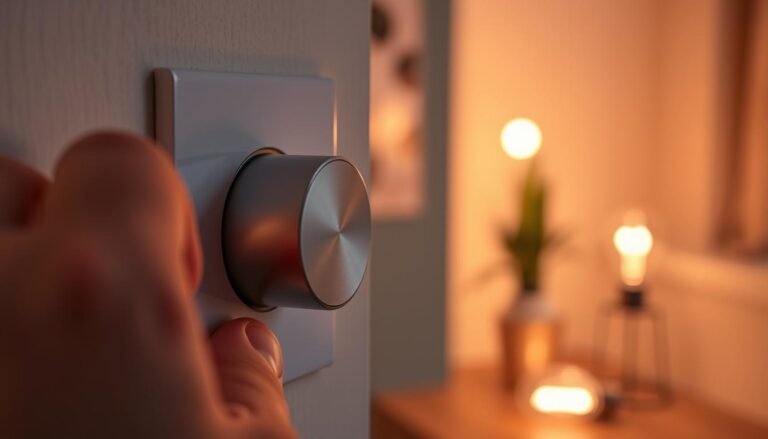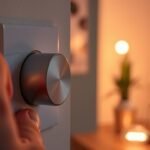Affiliate Disclosure: This post may contain affiliate links. If you make a purchase, we may earn a small commission at no extra cost to you.
Lux is a standardized unit of measurement for light level intensity, also known as illuminance. It represents the amount of light that falls on a surface. So, what is lux equivalent to? It is the illumination of a one-meter square surface that is one meter away from a single candle.

Let us help you find great lighting choices that fit your needs and style
Lux is commonly used to express the specified illumination levels required for different settings, such as commercial and industrial environments. Understanding the meaning of lux and how it is measured can help you achieve optimal lighting conditions for various applications.
Key Takeaways:
- Lux is a unit of measurement for light level intensity, also known as illuminance.
- One lux represents the amount of light that falls on a one-meter square surface one meter away from a single candle.
- Lux is commonly used to express specified illumination levels for different settings.
- Measuring lux requires the use of a light meter or illuminance meter.
- Understanding lux levels is important for achieving adequate lighting conditions in different environments.
What is Lux and How to Measure it?
To accurately measure the lux levels in a given space, a specialized tool called a lux meter, or illuminance meter, is used. This handy device allows you to determine the amount of light falling on a surface, providing a measurable illuminance reading.
Lux meters, also known as lux sensors or light meters, are designed to capture and quantify the brightness of the surrounding environment. They are calibrated to account for individual variations in perception and provide consistent and reliable measurements.
When using a lux meter, follow these steps to measure lux:
- Position the lux meter at the desired location where you want to measure the light intensity.
- Ensure that the environment and lighting conditions are stable and representative of the area you wish to assess.
- Activate the lux meter and allow it a few moments to stabilize and adjust to the ambient light.
- Read the illuminance value displayed on the lux meter. This reading represents the lux level in that particular spot.
It’s important to note that when measuring lux, the distance at which the measurement is taken should also be considered. The farther the light source is from the surface being measured, the lower the lux level will be. Similarly, bringing the lux meter closer to the light source will yield a higher lux reading.
Besides measuring lux, it’s equally important to assess the luminous flux of a light source, which is measured in lumens. Lumens indicate the total amount of light emitted by a single light source in all directions.
Lux and Lumens Comparison Table
| Lux | Lumens | |
|---|---|---|
| Definition | The unit of measurement for illuminance, representing the amount of light falling on a surface. | Not influenced by the distance |
| Measurement Device | Lux Meter (Illuminance Meter) | Goniosphere or Integrating Sphere |
| Measures | Light intensity on a surface | Total light output from a source |
| Distance Dependency | Varies based on the distance between the light source and the measured surface | Not influenced by distance |
Importance of Lux Levels in Lighting
The lux levels in lighting play a vital role in ensuring adequate illumination for various applications. Different settings require specific lux levels that have been determined through extensive visual testing and research.

What is Lux level for various areas? For instance, a typical classroom may require a light level of around 30-50 footcandles or 300-500 lux, while a professional laboratory may demand a light level of 75-120 footcandles or 750-1200 lux.
Having sufficient lux levels is particularly crucial for tasks that rely on visual accuracy, such as reading or photography. Inadequate lux levels can make it challenging to see and perform tasks effectively. To verify and measure light levels in different environments, lux meters and light meters are commonly used.
Understanding the relationship between lux and lumens, along with the recommended lux levels, allows for the creation of optimal lighting conditions for various applications.
By investing in appropriate lighting solutions that provide the required lux levels, you can enhance productivity, comfort, and safety in different settings. Whether it’s an office, a retail store, or a healthcare facility, maintaining the right lux levels ensures a well-lit environment that promotes visual clarity and reduces eyestrain.

It’s important to consider lux levels when designing lighting layouts and selecting lighting fixtures to achieve the desired illumination.
FAQ
What is a lux meter?
A lux meter, also known as an illuminance meter or light meter, is a device used to measure the amount of light falling on a surface, known as illuminance, in lux.
How does a lux meter work?
A lux meter works by using a sensor to measure the intensity of light hitting its surface. It then converts this measurement into a lux value, which represents the level of illuminance.
What is the definition of lux?
Lux is a standardized unit of measurement for light level intensity, specifically illuminance. It represents the amount of light that falls on a surface.
How do you measure lux?
Lux is measured using a lux meter, which is pointed in the direction of the light source and records the amount of light hitting its sensor. The resulting measurement is displayed as lux on the meter’s screen.
What is the relationship between lux and lumens?
Lux measures illuminance or the amount of light that falls on a surface. Lumens, on the other hand, measure the total amount of light emitted by a light source in all directions. While lux measures the intensity of light at a specific point, lumens measure the total light output of a source.
What are recommended lux levels for different settings?
Recommended lux levels vary depending on the setting. For example, a typical office may require around 500 lux, while a hospital operating room may need 1,000-2,000 lux. Specific industries and tasks have their own recommended lux levels based on visual testing and research.
Why are lux levels in lighting important?
Lux levels in lighting are important because they determine the amount of light available for tasks and activities. Insufficient lux levels can make it difficult to see and perform tasks effectively, while excessive lux levels may cause discomfort or glare.

Let us help you find great lighting choices that fit your needs and style
Check out our FREE Calculators on our Resources Page
Source Links
- https://greenbusinesslight.com/resources/lighting-lux-lumens-watts/
- https://bioslighting.com/how-to-measure-light-intensity/architectural-lighting/
- https://www.waveformlighting.com/home-residential/what-is-the-difference-between-lux-and-lumens








